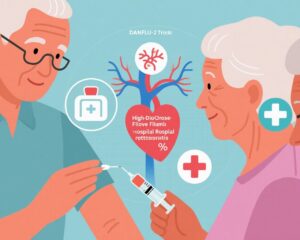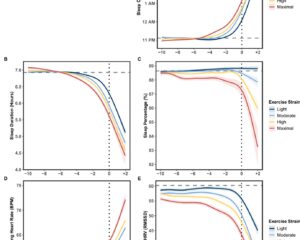Highlight
• Exercise echocardiography enables feasible and modestly reproducible assessment of cardiac output reserve in adults with Fontan palliation.
• Fontan patients exhibit significantly reduced cardiac output reserve during exercise compared to matched controls.
• Impaired cardiac output reserve correlates strongly with biomarkers of congestion (NT-proBNP) and predicts adverse cardiovascular events including death, transplant, and heart failure hospitalization.
• Cardiac output reserve assessment provides incremental prognostic value beyond traditional echocardiographic indices and peak VO2 measurements.
Study Background and Disease Burden
The Fontan procedure, a palliative surgery for complex congenital heart disease with single-ventricle physiology, enables survival into adulthood but imposes unique hemodynamic challenges. In Fontan physiology, systemic venous return is passively directed to the pulmonary arteries without a subpulmonary ventricle, leading to chronically elevated systemic venous pressures, limited preload, and variable cardiac output responses during exertion. Over time, Fontan patients risk developing heart failure, arrhythmias, and end-organ dysfunction, greatly increasing morbidity and mortality risk.
Cardiac output (CO) reserve, defined as the capacity to increase CO during exercise, is a cornerstone of cardiovascular performance and a key determinant of exercise tolerance and prognosis. However, assessing CO reserve noninvasively and reproducibly in Fontan patients remains challenging due to their altered anatomy and physiology. Exercise echocardiography, combining Doppler-derived hemodynamic measurements during controlled exercise protocols, offers a promising method for dynamic CO evaluation.
Nevertheless, the feasibility, reproducibility, and clinical relevance of exercise echocardiographic CO reserve assessment in adults with Fontan circulation have been insufficiently characterized. This represents a critical gap, as reliable measurement tools are necessary to inform risk stratification, guide therapeutic decisions, and evaluate intervention effectiveness in this fragile population.
Study Design
This prospective observational study included 37 adult patients with Fontan palliation and 61 age- and sex-matched healthy controls. Participants underwent exercise echocardiography using a supine cycle ergometer allowing staged workload increments. At rest and at each exercise stage, Doppler echocardiography was performed to derive cardiac output, alongside measurement of oxygen consumption (VO2).
The primary metric, cardiac output reserve, was quantified in two ways: change in cardiac output per watt of workload increase (∆CO/Watt) and change in cardiac output relative to change in oxygen consumption (∆CO/∆VO2). These indices reflect the efficiency of cardiovascular adaptation to exercise stress.
Reproducibility of Doppler-derived CO reserve measurements was assessed, and correlations between CO reserve and NT-proBNP levels (a biomarker of myocardial stress and congestion) were examined. Additionally, the prognostic value of CO reserve was tested by tracking subsequent adverse cardiovascular events, defined as death, heart transplant, or heart failure hospitalization, to evaluate whether CO reserve offers superior risk prediction compared with conventional echocardiographic and exercise capacity parameters.
Key Findings
Feasibility and Reproducibility: Cardiac output reserve assessment was feasible in 95% of the Fontan cohort, demonstrating successful data acquisition despite anatomical complexities. The reproducibility was modest but acceptable for clinical and research use, confirming that exercise echocardiography is a practical tool for serial evaluation in this population.
Reduced CO Reserve in Fontan Patients: At rest, Fontan patients and controls had similar cardiac output values. However, with increasing exercise workload, Fontan patients exhibited significantly lower CO reserve: ∆CO/Watt ratio was 46±17 mL/W compared to 57±19 mL/W in controls (P<0.001), and ∆CO/∆VO2 ratio was 4.48±1.02 mL/mL compared to 5.37±2.18 mL/mL (P=0.03). This reduction highlights impaired ability to augment cardiac output during physical stress in Fontan circulation.
Correlation with Congestion Biomarkers: There was a strong inverse association between cardiac output reserve and NT-proBNP levels, with correlation coefficients of r=0.65 for ∆CO/W ratio and r=0.53 for ∆CO/∆VO2 ratio (P<0.01 for both). Elevated NT-proBNP reflects myocardial strain and fluid overload, linking impaired CO reserve with hemodynamic congestion in Fontan patients.
Prognostic Value: Over a defined follow-up period, patients with reduced CO reserve were at higher risk of cardiovascular events (death, transplant, heart failure hospitalization). Cardiac output reserve metrics improved risk prognostication beyond standard echocardiographic parameters and treadmill peak VO2, as indicated by superior area under the receiver operating characteristic curve and C-statistics.
Expert Commentary
This study advances the field by demonstrating that exercise echocardiography is not only feasible but also clinically meaningful for assessing cardiovascular reserve in adults with Fontan physiology. The findings support the biological plausibility that limited preload and passive pulmonary flow characteristic of Fontan circulation constrain dynamic cardiac output augmentation during exercise.
Strong correlations with NT-proBNP underscore the pathophysiological link between diminished cardiac output reserve and myocardial stress, which has therapeutic implications. Importantly, the prognostic superiority of CO reserve assessments suggests that this modality could refine clinical risk stratification and guide timely intervention.
However, the modest reproducibility highlights the technical challenges inherent in Doppler measurements during exercise and necessitates operator expertise and adherence to standardized protocols. Furthermore, whether improving CO reserve through medical or surgical interventions translates into better clinical outcomes requires dedicated interventional studies.
Conclusion
Exercise echocardiography-based assessment of cardiac output reserve is a feasible and clinically valuable approach for adults with Fontan physiology. Fontan patients demonstrate substantially impaired cardiac output reserve during exercise, which correlates with congestion biomarkers and predicts adverse cardiovascular events. These findings advocate for incorporating CO reserve evaluation into routine surveillance and research protocols to enhance personalized care.
Future studies should focus on validating interventions aimed at improving CO reserve and evaluating whether serial changes in CO reserve can serve as reliable surrogate endpoints for therapeutic response in this unique population.
References
Egbe AC, Abozied O, Abdelhalim AT, ElZalabany S, Kholeif Z, Reddy YNV, Borlaug BA. Feasibility, Reproducibility, and Prognostic Value of Exercise Echocardiography for Cardiac Output Reserve Assessment in Fontan Physiology. Circ Heart Fail. 2025 Aug 26:e012908. doi: 10.1161/CIRCHEARTFAILURE.125.012908



